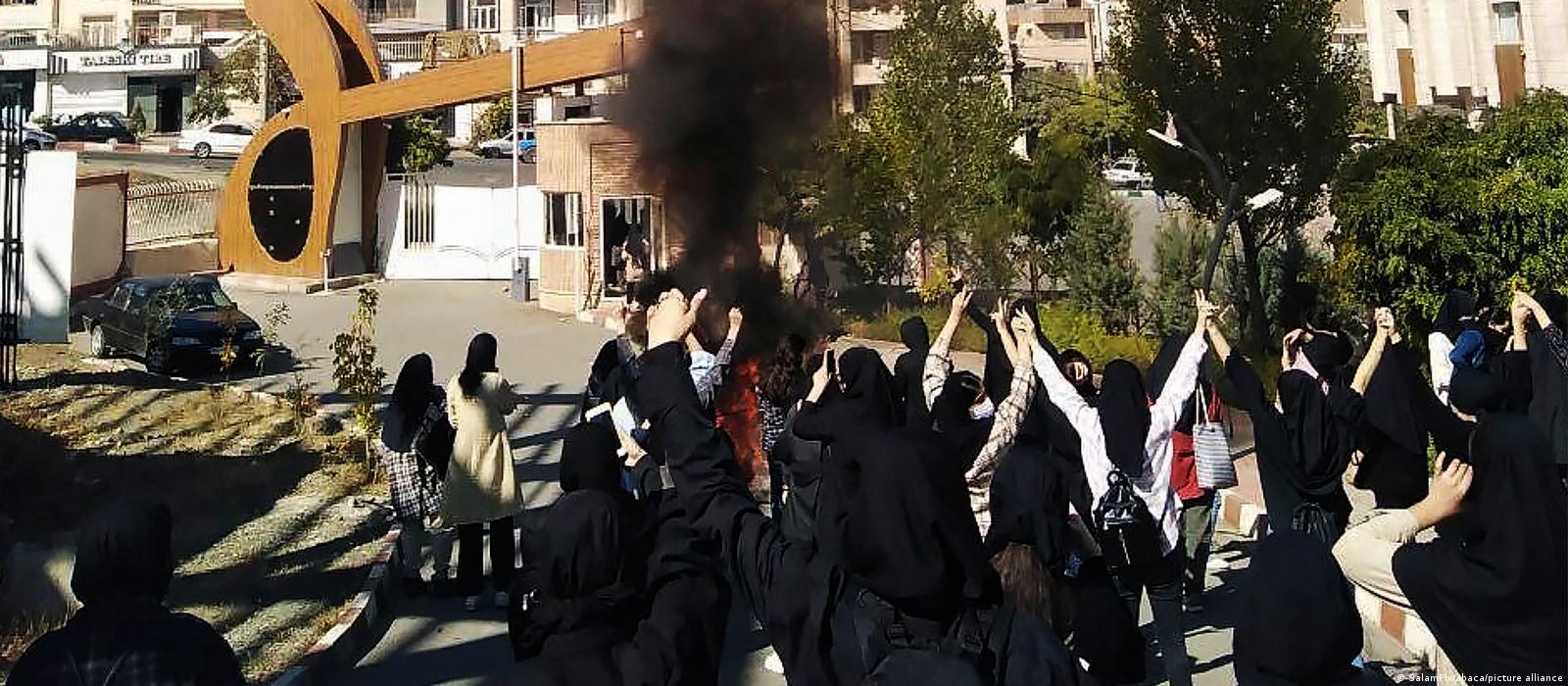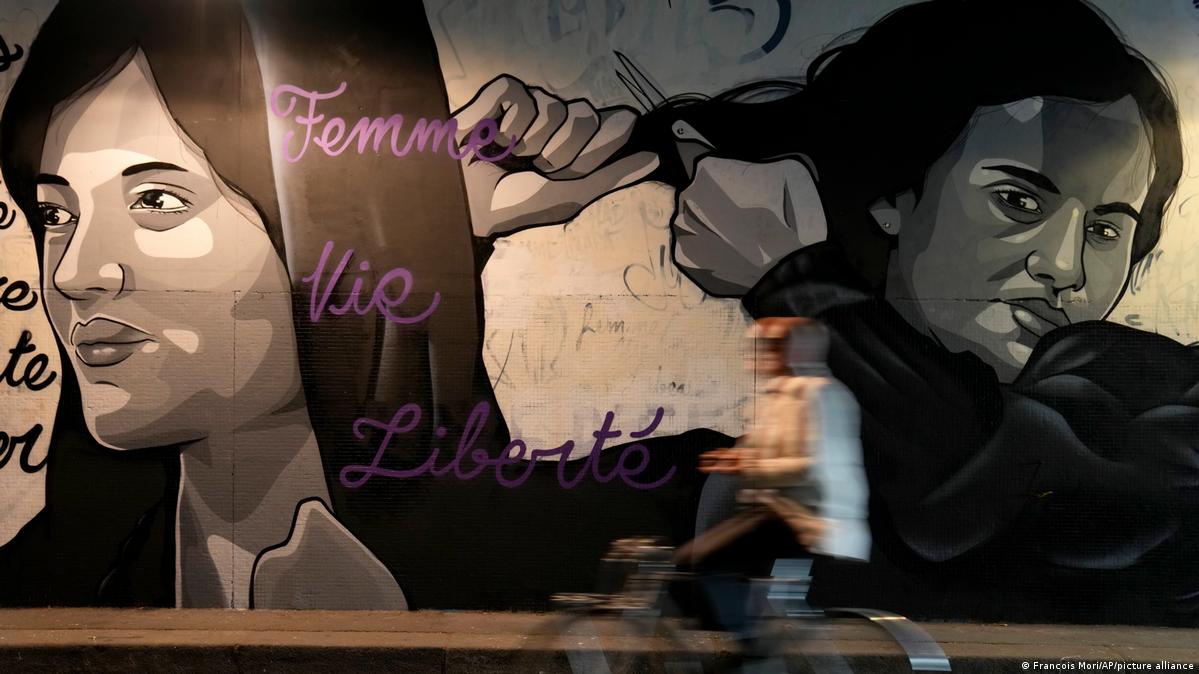
Universities in Iran have turned into a battleground between authorities and student demonstrators. The latest protests mirror the experiences of earlier generations.
Kersten Knipp
https://p.dw.com/p/4J9ln
In videos circulating on social media, male and female students students on Iranian university campuses are seen eating together, often outside the gender-segregated dining halls that were closed after students tore down the walls dividing men and women.
Eating together in front of the closed cafeterias is considered act of resistance. The videos are an act of protest and solidarity with anti-government demonstrations that have been going on for months in Iran.
In many videos, protesters holding placards also draw attention to fellow students who have been arrested. According to media reports, about 300 students have been detained by authorities .
The protesters appear not to be intimidated by the government's clampdown on the demonstrations.
"A student may die but will not accept humiliation," they chanted at Shahid Chamran University of Ahvaz, in the southwestern province of Khuzestan, in an online video verified by AFP.
The university students also show solidarity with Iranian schoolchildren, who are active in the protests and, as a result, paying a price.
Could Iran's protest movement pose a threat to the regime?
03:19
Schoolgirls at the Shahid Sadr Girls' Vocational School in Tehran, for instance, were recently beaten for taking part in the demonstrations, according to activists.
"Schoolgirls from Sadr High School in Tehran were attacked, strip-searched and beaten," the activist group 1500tasvir reported.
Iran's Education Ministry has denied reports that a female student was killed in the confrontation, according to the ISNA news agency.
Khomeini's mistrust of universities
Since the Islamic Revolution in 1979, Iranian students have faced pressure from the Muslim clergy.
When the Shah was overthrown, some sections of students, motivated by either Islamism or socialism, initially stood by the revolutionary leader, Ayatollah Khomeini.
But the two sides became estranged immediately after the new Islamic regime was established.
Students bore witness to how classmates who disagreed with the new leaders were kidnapped or killed by the regime's security forces. The mistrust between the two sides ran so high that the Revolutionary Council shut down all of the nation's universities in June 1980.
The decision was in line with Khomeini's distrust of students and professors. "We are not afraid of military attacks," he said. "We are afraid of colonial universities."
At the time, the regime viewed universities as the home of the "people's mujahedeen," which was the main source of opposition to the leadership.
Khomeini's supporters "removed thousands of books with 'anti-Islamic tendencies' from libraries and expelled thousands of teachers and professors from their posts labeling them 'lackeys of Western ideology,'" journalist Gerhard Schweizer wrote in his book "Understanding Iran."
Leading universities remained closed for years.
'Nothing more than a cultural revolution'
Khomeini's call had severe consequences, Mehdi Jafari Gorzini, an Iranian political analyst living in exile, told DW.
"Thousands of students were forcibly de-registered," Jafari Gorzini said. "Some fled abroad, while others were arrested and executed. Khomeini sought nothing more than a kind of 'cleansing' of the universities. In essence, this was nothing more than a cultural revolution."
Since their reopening, Iranian universities have been consistently expanded and modernized. The result is that they now have more than 4 million students enrolled, according to a study by the German Academic Exchange Service (DAAD). Modernization is also reflected in gender equality, with the proportion of female students in Iranian universities currently exceeding 50%.
According to DAAD, the Iranian university system also focuses on quality assurance and enhancement. Many Iranian scientists who were educated abroad, especially in the West, have also contributed to this development.
But, with the arrival of liberal ideas, the universities once again became centers of opposition. This was evident, for example, in July 1999.
At that time, the government decided to close the reform-oriented newspaper Salam. Students at Tehran University took to the streets in protest. Security forces then raided the dormitories on campus. At least one student was killed and hundreds were injured.
The protests soon morphed into a broader movement demanding accountability from the government. The memory of the security forces' brutality at the time is still fresh in the student milieu today, Jafari Gorzini said.
Liberal leanings and greater awareness
The students can still count on the liberal leanings of many professors. At the end of September, about 70 professors from Tehran University published an open letter to the government in the newspaper Etemad.
In it, they clearly described the political and economic grievances of the country and demanded the release of all demonstrators.
Iran protests: Rallies and graffiti worldwide in support of Iranian women
Graffiti artists all over the globe are creating art in support of the women-led anti-government demonstrations raging in Iran for the past few weeks. Solidarity rallies are also being held in various cities worldwide.
Francois Mori/AP/picture alliance

At the Iranian Embassy in Mexico City
A woman spray-paints messages against "macho country" Iran on a wall of the Iranian Embassy in Mexico City in solidarity with Iranian women and in memory of Jina Mahsa Amini — the 22-year-old woman who died in custody after she was detained by Iranian authorities for allegedly violating strict Islamic dress codes for women.Image: Gerardo Vieyra/NurPhoto/picture alliance

At a demonstration in Frankfurt
Protests calling for the fall of the Islamic regime have swept the Middle Eastern nation following the death of the 22-year-old in mid September. Authorities have denied responsibility for Amini's death but few believe them. Many women have experienced the brutality of the so-called morality police. This image shows protesters taking to the streets in Frankfurt in support of Iranian women.
Simpsons in solidarity in Milan
In Iran and abroad, many women have been cutting off locks of their hair in a gesture of support for the protest movement. On a wall in the Italian city of Milan, directly opposite the Iranian consulate, Marge
Jina Mahsa Amini to become honorary citizen of Paris
In Paris, it's not just murals that commemorate Jina Mahsa Amini and the protest movement. The French capital is also planning to posthumously make Amini an honorary citizen, Mayor Anne Hidalgo has said. A location in the city would also be named after Amini "so that no one forgets her," she noted. "Paris will always be on the side of those who fight for their rights and their freedom."Image: Francois Mori/AP/picture alliance
'Women, Life, Freedom' in Frankfurt
Artists from "Kollektiv ohne Namen" (Collective Without Names) have painted a picture of the Kurdish activist on a vacant building in Frankfurt. Next to it are the Kurdish words "Jin, Jiyan, Azadi" — women, life, freedom. This is the omnipresent slogan of the demonstrators against the Islamic regime in Tehran, borrowed from the Kurdish feminist movement in Syria.
Solidarity in Polan
The uprising of girls and women against their oppressors in Iran deserves solidarity, say many women worldwide. And they are taking to the streets around the world — as seen here in Krakow, Poland. In many places across the globe, women are disadvantaged or even discriminated against because of their gender. The idea of a feminist revolution in Iran has attracted their support.
Protest performance by art students in Tehran
Art students from Azad University in Tehran protested in front of the art faculty building on Monday, October 9. The red paint on their hands symbolizes the bloody repression of the protests by the security forces.
Desired domino effect
The protests following the death of Jina Mahsa Amini are not directed solely against the strict dress codes for girls and women. Throughout the country, demonstrators are questioning the legitimacy of the Islamic regime and chanting slogans like "Get rid of the mullahs" or "Death to the dictator," targeting the country's Supreme Leader Ayatollah Ali Khamenei.Image: NNSRoj
In the days that followed, the faculty of other universities formulated similar letters. However, this also widened the rift within the universities, as leadership roles within these institutions are held by confidants of the regime.
In addition to being well-educated, the students are also very familiar with life outside Iran's borders thanks to the new media, Jafari Gorzini said.
"Since the early 2000s at the latest, many young people, including students, have had their own blogs or webpages, and have used them to communicate with people in other countries," he said.
"This showed them how life is beyond the borders and at the same time gave them other concepts of life than the one spread by the regime," he added.
In addition, people have repeatedly tried to vote the system out of office, Jafari Gorzini said. "But that never worked, nor did attempts to initiate reforms. Even the youngest generation understood that."
They have been told by their parents the stories of failed attempts at reform, demonstrations and large protests, Jafari Gorzini said. "It is clear to this generation that everything so far has been in vain, that there can be no dialogue with the mullahs. Hence the radicalism we are experiencing right now."
This article was originally written in German.

Kersten Knipp Political editor with a focus on the Middle East
No comments:
Post a Comment